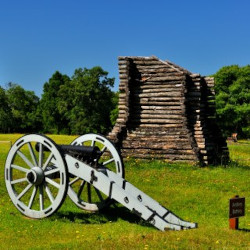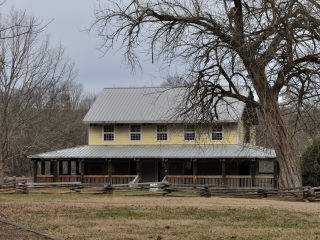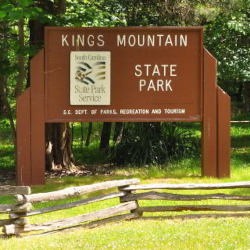Kings Mountain National Military Park
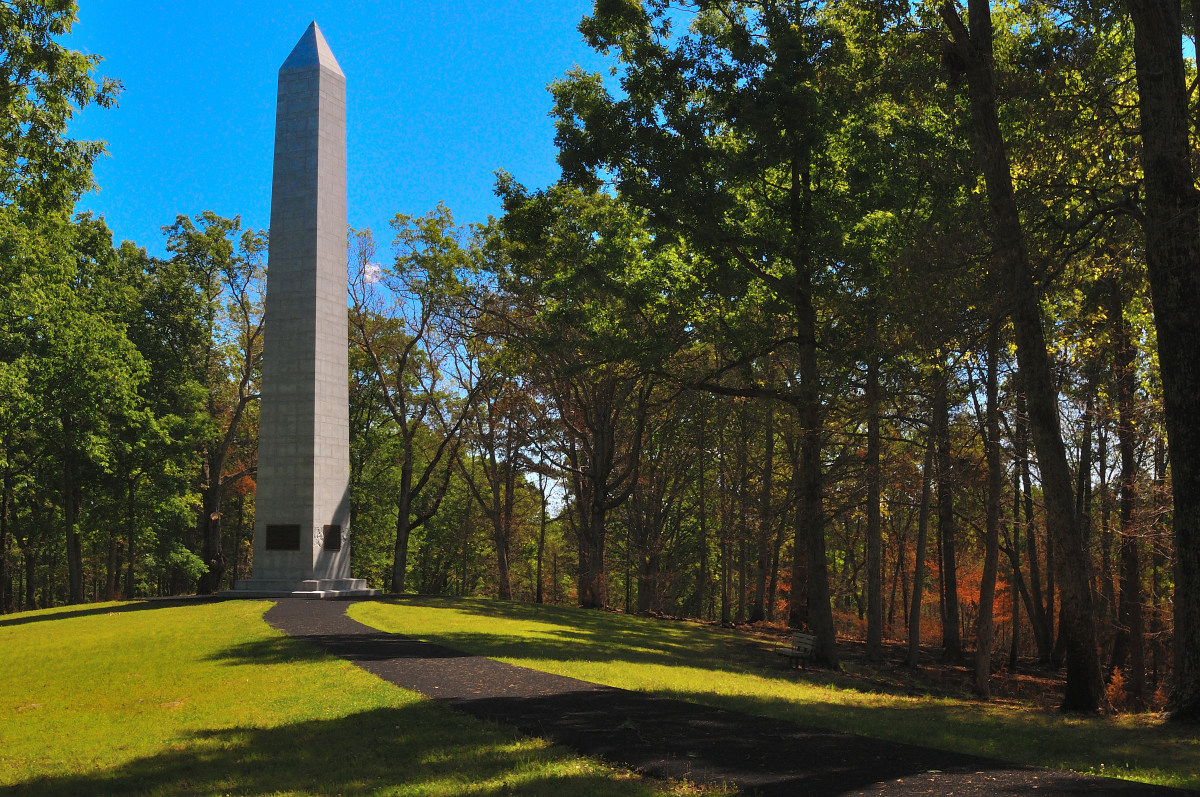
Visiting Kings Mountain National Military Park
Kings Mountain National Military Park commemorates the 1780 battle that took place here with not just a visitor center and Battlefield Trail but numerous monuments and markers including one of the oldest Revolutionary Way memorials placed here on July 4, 1815.
The visitor center features a museum and short film about the battle, but the real highlight of any visit to Kings Mountain is the Battlefield Trail which starts right behind the visitor’s center and loops back around.
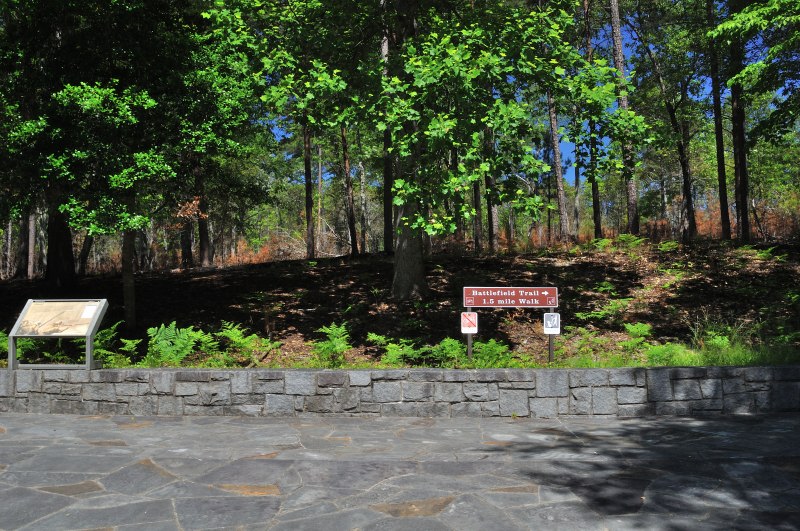
The trail is about 1.5 miles long and paved for the entire loop. But beware that there are some steep areas along the trail, so although it’s paved, wheelchairs or walkers might not be a good idea. There are a lot of benches along the path, so even people with somewhat limited mobility can still enjoy the it.
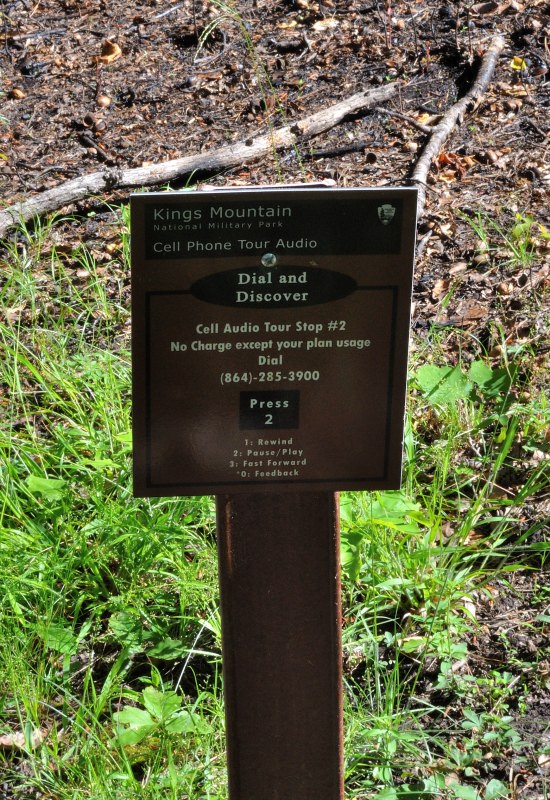
Along the footpath there are a number of interpretative kiosks pointing out important spots along the trail as well as a self guided walking tour you can access by calling a phone number. The path takes you from the point where the Patriot forces first began their assault on the mountain, to where the first shots were fires, to the spot where British Major Patrick Ferguson fell and was burred after the Patriot victory.
The park is very well maintained and everything is clean and in good working order. The paved trail is nice and easy to walk on. Most of the people I saw in the park looked like locals who walk the trail for their daily exercise.
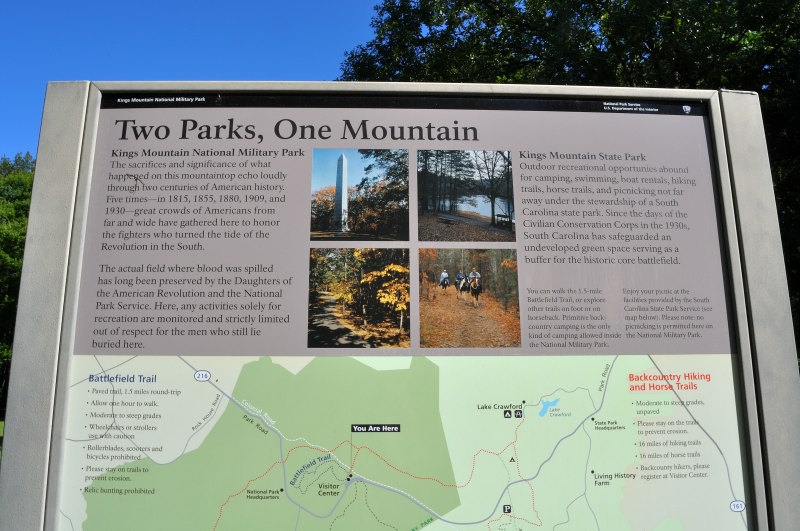
There aren’t any recreational facilities, but it’s just a short drive down the main park road to Kings Mountain State Park. There you’ll find plenty of spots for picnicking, camping, horseback riding, and hiking. Some of the hiking trails in the state park connect not only to the Military Park but one also connects to nearby Crowders Mountain State Park in North Carolina. The Living History Farm at the state park is a great addition to a day at the Military Park. There you’ll get to see how local folks lived around the time of the Revolution and for a century after.
For details on our visit check out our Kings Mountain National Military Park Field Report
The Battle at Kings Mountain
Lord Charles Cornwallis sipped his morning tea as he read his correspondence. He enjoyed these morning respites as they gave him time to reflect on the past few weeks.
It had been less than two months since he routed the Patriot Army under Horatio Gates at the Battle of Camden on August 16, 1780 followed by Lieutenant Colonel Banastre Tarleton’s defeat of Colonel Thomas Sumter known as the Fighting Gamecock at Fishing Creek two days later.

He had just read a communique from his field commander Major Patrick Ferguson who was charged with recruiting soldiers loyal to the Crown as well as protecting the main army’s western flank. Since September 25th, Cornwallis and his army had been sitting in Charlotte, North Carolina waiting for this moment.
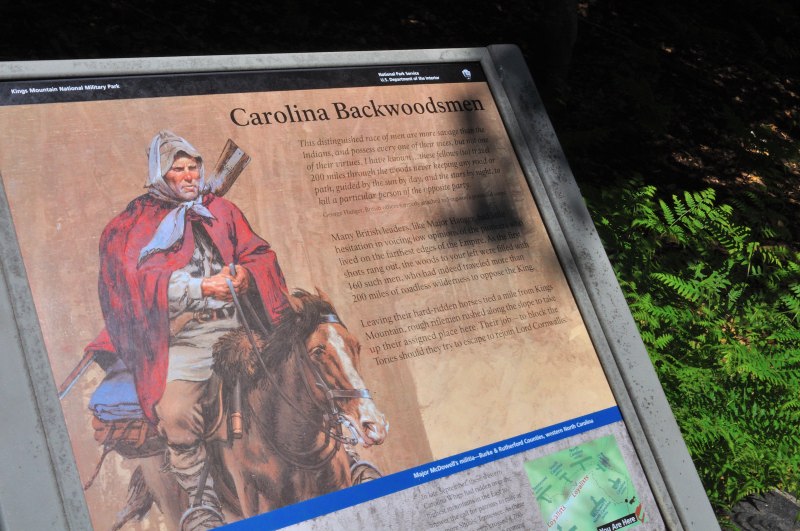
Ferguson had earlier sent word of an uprising of troops heading for the North Carolina/South Carolina border. This army of frontiersmen had set out from Sycamore Shoals in modern day Tennessee on September 26, 1780. Described best as
men in buckskin, white by blood and tradition, but half Indian in habit and instinct…They resolved not to await the attack, but to anticipate it. Without order or authority from Congress, without tents, commissary, or supplies, the Indian fighters of Virginia, North Carolina, and Tennessee quickly assembled at the Sycamore shoals of the Watauga”-
James Mooney from Myths of the Cherokee (1900)
On October 5 this rag tag army of misfits made camp at Alexander’s Ford along the Green River where they were informed of Patrick Ferguson’s position.
In his his last message to Lord Cornwallis dated October 6, 1780 Ferguson wrote, “I arrived today at Kings Mountain and have taken a post where I do not think I can be forced by a stronger enemy than that against us.”
This was the news Cornwallis had been waiting for. Soon he could march his army through North Carolina and into Virginia, connecting with British troops that General Clinton would send from New York. The end of the rebellion was finally in sight. Just a few more weeks and he could return home in victory. A smile broke across his face at it began to drizzle. “Today will be a good day”, he thought.
The Patriots Approach Kings Mountain

Not too far away, Isaac Shelby and the other Overmountain Men had been marching all night in that same drizzling rain. Their 330 mile journey would soon come to an end. They knew where Ferguson was and they were within striking distance.
As they approached the mountain in the early afternoon of October 7, 1780, they split into two columns of equal strength. At the base of the Kings Mountain, the two columns split again into 8 detachments and silently surrounded the mountain.
Orders were simple. Once fighting begins, there would be no single commander. Each soldier knew the plan and what to do. They were told to be their own commanders. Shortly before 3:00, all Patriot forces were in position.
At the top of Kings Mountain
Patrick Ferguson had chosen what he thought was a supremely defensible position. Overly confident, this Scottish born soldier was not only the sole regular army officer on either side, but he was the only one to have been born in the British Isles. All the men under his command were born in the colonies, and in some cases were friends and neighbors of the men now surrounding their position.

The leaves around the mountain were all wet from the rain that fell the night before, so they gave no sound as roughly 900 patriots crept up the mountain. No one noticed shadows moving from tree to tree and rock to rock in the distance.
Having utter contempt for the untrained and ill equipped men opposing him, Ferguson failed to even fortify his encampment. All was well as far as he knew. He was dreaming of an easy victory and the glory it would bring right up until 3:00 in the afternoon when the first shots rang out.
Loyalist forces faced fire from all directions. Patriot’s fought frontier style, hiding behind trees and rocks while at the top of the hill, the Loyalists were clearly silhouetted against the afternoon sky.

As panic began to grip his men, Patrick Ferguson refused to give up. Mounting his horse, he rallied his men and led a bayonet charge down the mountain. The Patriots simply dispersed into the woods only to reform and charge up the hill again.
Ferguson was trapped on this mountain without any other option, and he knew it. It was either lead futile charge after futile charge or surrender, and he was not about to surrender.

As Patriot forces reached the top of the mountain and commenced a final push into the Loyalist camp, white flags began to fly from the defeated British. Ferguson still on his horse drew his sword and cut down any white flag he saw.

In a last ditch attempt to save the day, he rallied some of his officers for a final charge just as they were struck by a volley of musket fire. Ferguson fell from his horse and was dragged behind Patriot lines where an officer demanded his surrender. Defiant to the end, Patrick Ferguson pulled his pistol and shot the man dead. He was then fired on by multiple Patriots. After the battle, seven bullet wounds were found in his body.

Seeing their leader die demoralized the last of the Loyalist holdouts, and they began to surrender en mass. But remembering how the British under Banastre Tarleton had continued killing Patriots after the surrender of Abraham Buford at the Battle of Waxhaws, shouts of “Give ’em Tarleton’s Quarter!” and “Give them Buford’s play!” rang out between rifle volleys until Patriot officers got the situation under control.
The battle lasted for 65 minutes and resulted in a total patriot victory.
Aftermath of Kings Mountain

The Patriot army was in the process of dispersing when word of the defeat at Kings Mountain reached Charlotte. However at the time, Cornwallis didn’t know what their plans were. With his western flank now exposed, he gave up on his plans to march through North Carolina, and abandoned Charlotte on October 14. Returning to South Carolina where his army could receive support form outposts at both Ninety Six and Camden, his northward march would be delayed until the following year. By that time Nathanael Greene would be commanding the newly reconstituted Southern Continental Army.
Sir Henry Clinton, the commander of all British forces in North America, called the defeat at Kings Mountain “an event which was immediately protective of the worst Consequences to the King’s affairs in South Carolina, and unhappily proved the First Link of a Chains of Evils that followed each other in regular succession until they at last ended in the total loss of America.”
Legacy of Kings Mountain
Despite being the first in a chain of events that lead to the eventual British surrender at Yorktown, Kings Mountain soon faded from the national consciousness. With that a new fight began, the battle for national recognition. While the confrontation with the British would only last 65 minutes, the battle with the federal government over recognition would take over a hundred years.
While people around the country may have forgotten the Battle of Kings Mountain, locals and veterans alike worked to keep the memory alive, and the banner was soon taken up by the Daughters of the American Revolution.

The earliest remembrance took place on July 4, 1815 and was initiated by Dr. William McLean of Lincoln County, North Carolina. After hearing that wolves had been digging up the remains of the dead who had been hastily burred after the battle, he and a group of locals returned to properly bury the dead. When finished, McLean erected a small stone monument to Maj. William Chronicle, Capt. John Mattocks, William Rabb, and John Boyd near where they died. Known today as the Chronicle Marker, it is one of the first such commemorative memorials in the nation.
A gathering on October 4, 1855 brought 15,000 people to the mountain to remember the seventy-fifth anniversary of the battle. But it wasn’t until 25 years later on October 5, 1880 when the largest to date convergence took place. This three day event on the 100th Anniversary of the Battle saw the Kings Mountain Centennial Association not only purchase 39 acres of the battlefield but they also unveiled the Centennial Monument at the spot where the first shots were fired and the site of the most intense fighting.

Up to this point, all monuments and commemorations had been paid for with private funds including the purchase of the battlefield. In 1898, the Daughters of the American Revolution Kings Mountain Chapter would take over the battlefield property and the fight for national recognition.

In 1909, the US Congress authorized $30,000 for the construction of the first “official” monument at Kings Mountain. Around 9000 people showed up for the unveiling of the US Monument at the highest point of the ridge. Located where the British were camped it sits not far from the spot where Ferguson fell. Forming a line along the ridge with the Centennial Monument they mark the start and the end of the battle.
Many in Washington felt that the 1909 Monument was all the recognition that Kings Mountain deserved. The DAR, however, kept pushing for the establishment of a national military park but with little success. Then on the sesquicentennial anniversary of the battle things started to change. On October 7, 1930, President Herbert Hoover spoke to a crowd of 75,000 gathered on the mountain including more than a hundred news agencies.

His words that day: “This is a place of inspiring memories. Here less than a thousand men, inspired by the urge of freedom, defeated a superior force entrenched in this strategic position. This small band of Patriots turned back a dangerous invasion well designed to separate and dismember the united Colonies. It was a little army and a little battle, but it was of mighty portent. History has done scant justice to its significance, which rightly should place it beside Lexington, Bunker Hill, Trenton and Yorktown.”
With those words it was clear that things were now in motion. HR 6128 passed on March 3, 1931 formally established Kings Mountain National Military Park under the jurisdiction of the Department of War.
Building Kings Mountain National Military Park
Work on the park didn’t start until after August 1933 when Executive Order 6166 transferred all battlefield and historic sites and monuments managed by the War Department to the National Park Service including the 39 acres at Kings Mountain.

The NPS along with the Civilian Conservation Corp chose to not only develop the Military Park but also build an adjacent State Park with recreational facilities.
As the battleground had been in almost consistent development and maintained privately since 1815, there wasn’t much work for the CCC to do. Most of their work was building roads, revitalizing the plant life along the mountains slopes and ridge, and the construction of a few buildings. Because the State Park would have ample recreational opportunities for camping, picnicking, and swimming no recreational facilities were built.
Fast Facts About Kings Mountain National Military Park
| Type: | Historical Site – American Revolution Battlefield |
| Admission: | Free |
| Location: | 2625 Park Rd, Blacksburg, SC 29702 |
| Website: | https://www.nps.gov/kimo/index.htm |
| Phone | (864)936-7921 |
Things to do: Walk the battlefield trail, visitor center, recreational facilities nearby at the state park



